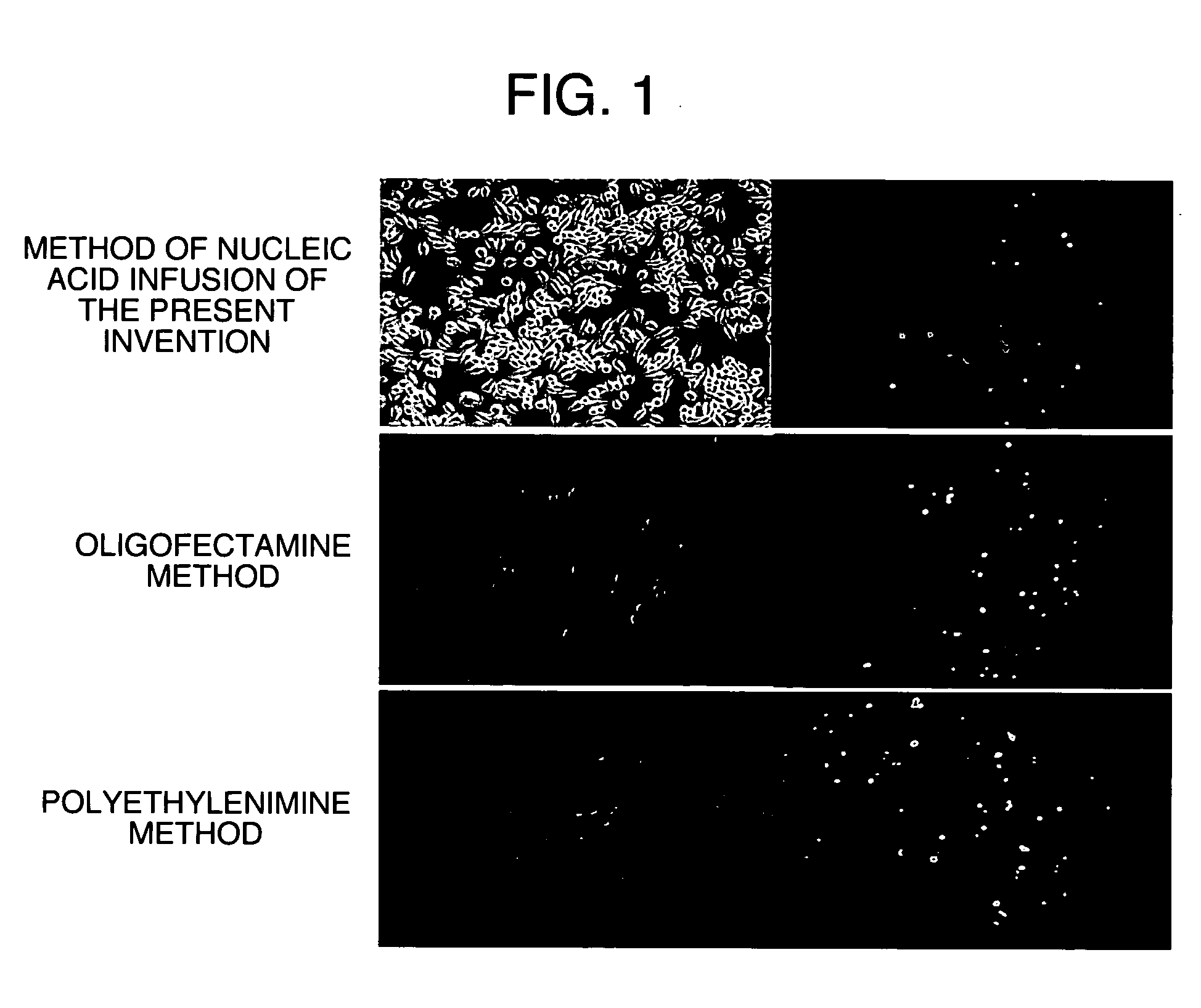Method of nucleic acid infusion
- Summary
- Abstract
- Description
- Claims
- Application Information
AI Technical Summary
Benefits of technology
Problems solved by technology
Method used
Image
Examples
example 1
[0149] Infusion of Oligonucleotide into Murine Macrophage-Like Cell Line RAW264.7 Cell Using Method of Nucleic Acid Infusion of the Present Invention and Conventional Methods
[0150] Murine macrophage-like cell line RAW264.7 cells were used to compare a method of nucleic acid infusion of the present invention that utilized osmotic shock (hereinafter, also referred to as an osmotic transfection method) with conventional methods.
1-1) Infusion of Oligonucleotide into Murine Macrophage-Like Cell Line RAW264.7 Cell by Method of Nucleic Acid Infusion of the Present Invention
1. Preparation of Cell
[0151] RAW264.7 cells (ATCC No. TIB-71) were suspended in RPMI1640 (Invitrogen) containing 10% (v / v) fetal calf serum. The resulting cells were seeded at a density of 100000 cells / well into a 24-well plate (Nalge Nunc) and cultured overnight under conditions of 37° C. and 5% CO2.
2. Preparation of Hypertonic Solution Containing Oligonucleotide
[0152] A hypertonic solution containing oligonucl...
example 2
[0165] Infusion of TLR4 siRNA into RAW264.7 Cell by Method of Nucleic Acid Infusion of the Present Invention and Measurement of siRNA Effect by Quantitative PCR
1. Infusion of TLR4 siRNA into RAW264.7 Cell by Method of Nucleic Acid Infusion of the Present Invention
[0166] TLR4 siRNA (double-stranded RNA with a sense sequence 5′-AUCCACAAGUCAAUCUCUCUU-3′; SEQ ID NO: 2 and an antisense sequence 5′-GAGAGAUUGACUUGUGGAUUU-3′; SEQ ID NO: 3) was synthesized by Proligo. Negative Control #1 siRNA was purchased from Ambion. The infusion of TLR4 siRNA and Negative Control #1 siRNA into RAW264.7 cells by the method of nucleic acid infusion of the present invention was performed by the same approach as the above-described Example 1-1) after a hypertonic solution containing 10 μM TLR4 siRNA or Negative Control #1 siRNA was prepared in the same way as Example 1-1).
2. Collection of Total RNA from Infused Cell and Quantitative PCR
[0167] After 24 hours of infusion, total RNA was collected from the...
example 3
[0172] Infusion of TLR4 siRNA into RAW264.7 Cell by Method of Nucleic Acid Infusion of the Present Invention and Bioassay Using Knockdown Cell
[0173] TLR4 is a receptor of LPS (Calbiochem) and GLA-60 (WAKO CHEMICAL), and RAW264.7 cells are known to induce TNFα production by the stimulation of the cells with these compounds. Therefore, TLR4 siRNA was infused into RAW264.7 cells as described in Example 2. After 24 hours, the cells were scraped with a scraper and suspended in a growth medium. The resulting cells were seeded at 10000 cells / well to a 96-well plate and cultured at 37° C. under 5% CO2. After 48 hours of the infusion of siRNA, the resulting culture supernatant was removed. Stimulation without or with 10 μg / ml GLA-60 or 10 ng / ml LPS for 8 hours was performed to collect the culture supernatant. Instead of TLR4 siRNA, Negative Control #1 siRNA (Sequitur) was infused as a control under the same conditions. After 48 hours, the resulting culture supernatant was removed. Stimulati...
PUM
| Property | Measurement | Unit |
|---|---|---|
| Molar density | aaaaa | aaaaa |
| Molar density | aaaaa | aaaaa |
| Molar density | aaaaa | aaaaa |
Abstract
Description
Claims
Application Information
 Login to View More
Login to View More - R&D
- Intellectual Property
- Life Sciences
- Materials
- Tech Scout
- Unparalleled Data Quality
- Higher Quality Content
- 60% Fewer Hallucinations
Browse by: Latest US Patents, China's latest patents, Technical Efficacy Thesaurus, Application Domain, Technology Topic, Popular Technical Reports.
© 2025 PatSnap. All rights reserved.Legal|Privacy policy|Modern Slavery Act Transparency Statement|Sitemap|About US| Contact US: help@patsnap.com



